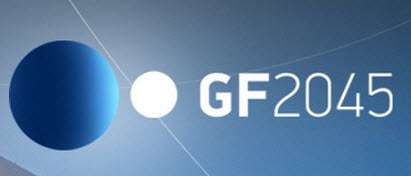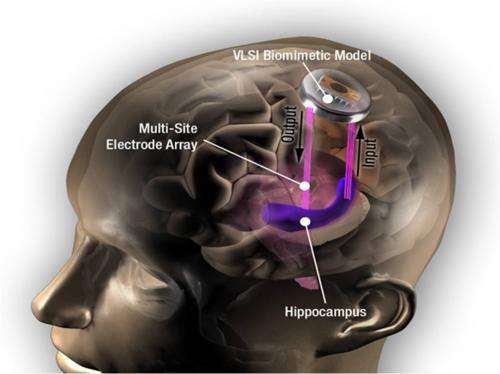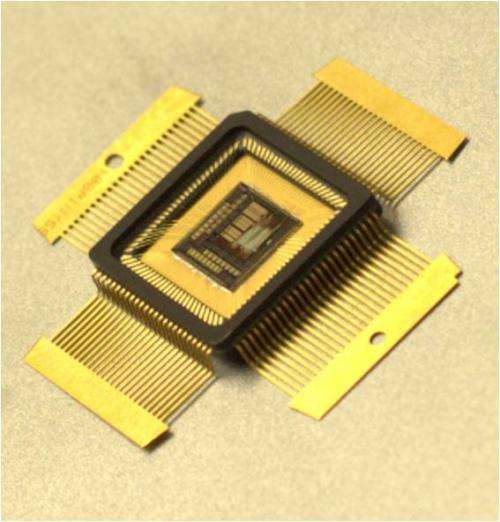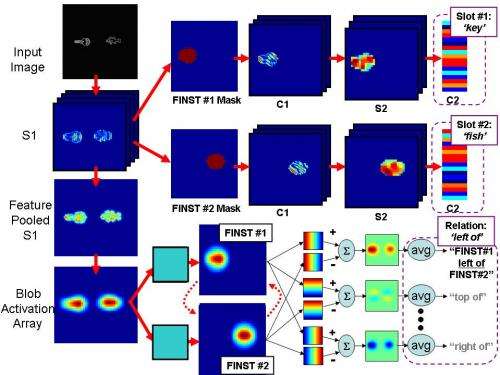August 9, 2013 feature
The world according to Itskov: Futurists convene at GF2045 (Part 2)

As many Phys.org readers undoubtedly know, Einstein famously said that imagination is more important than knowledge – but there's more to it. The full quote reads: I believe in intuition and inspiration. … At times I feel certain I am right while not knowing the reason. When the eclipse of 1919 confirmed my intuition, I was not in the least surprised. In fact I would have been astonished had it turned out otherwise. Imagination is more important than knowledge. For knowledge is limited, whereas imagination embraces the entire world, stimulating progress, giving birth to evolution. It is, strictly speaking, a real factor in scientific research.1
Futurists, visionaries, scientists, technologists, philosophers, and others who take this view to heart convened on June 15-16, 2013 in New York City at Global Futures 2045 International Congress: Towards a New Strategy for Human Evolution. GF2045 was organized by the 2045 Strategic Social Initiative founded by Russian entrepreneur Dmitry Itskov in February 2011 with the main goals of creating and realizing a new strategy for the development of humanity – one based upon our unique emerging capability to effect self-directed evolution. The initiative's two main science projects are focused largely on Transhumanism – a multidisciplinary approach to analyzing the dynamic interplay between humanity and the acceleration of technology. Specifically, the 2045 Initiative's projects seek to (1) enable an individual's personality to be transferred to a more advanced non-biological substrate, and (2) extend life to the point of immortality – and those skeptical about the likelihood of achieving these goals should consider Arthur C. Clarke's laws of prediction2:
1. When a distinguished but elderly scientist states that something is possible, he is almost certainly right. When he states that something is impossible, he is very probably wrong.
2. The only way of discovering the limits of the possible is to venture a little way past them into the impossible.
3. Any sufficiently advanced technology is indistinguishable from magic.
The first speaker on GF2045's second day was inventor, futurist and author Ray Kurzweil, who Immortality By 2045 presentation was focused on reverse engineering the brain. While much of his presentation was familiar to those who have followed his work on technology trend analysis and the Singularity, his material on the brain – also appearing in his recently-published How to Create a Mind3, and in part the purpose of his joining Google (to work on new projects involving machine learning and language processing) – focused on ideation rather than implementation.
Kurzweil's brain reengineering approach is based largely on what he terms the Pattern Recognition Theory of Mind (PRTM), which he says describes the basic algorithm used by the neocortex – a brain structure found only in mammals that has evolved into its most complex form in human beings, and where perception, memory, language, reasoning, and abstract thought occur. Kurzweil proposes that the neocortex is hierarchically organized into some 300 million pattern recognizers, each one a 100 neuron cluster arranged in a vertical column, with columns (rather than individual neurons) communicating with one another. His main assertion is that the brain uses these hierarchical pattern recognizers for virtually all aspects of thought, not just for perception.
It should be noted that Kurzweil's pattern recognition thesis has been proposed in various, notably by Jeff Hawkins and Dileep George several years ago in Hierarchical Temporary Memory4 – their theoretical framework, covered in detail in Hawkins' book, On Intelligence5 – for how the hierarchical structure of the neocortex builds a model of the world. Moreover, at Numenta, Hawkins' and (previously) George's company (George is now at Vicarious), Hierarchical Temporary Memory has been embodied in a technology platform being applied to pattern discovery and inference.
Interestingly, regarding Kurzweil's best-known concept, the technological Singularity, the term was actually first introduced in its non-astrophysical context by now-retired San Diego State University mathematics professor Vernor Vinge in his 1981 novella True Names6 – and which he discussed at length in his 1993 paper, The Coming Technological Singularity7. (As it turns out, Vinge and Kurzweil discussed the Singularity in 2002.)
Dr. Theodore Berger, David Packard Professor of Engineering, Professor of Biomedical Engineering and Neurobiology, and Director of the Center for Neural Engineering at the University of Southern California, gave the most groundbreaking presentation of the Congress – one that also received a standing ovation. In Engineering Memories: A Cognitive Neural Prosthesis for Restoring and Enhancing Memory Function, Berger discussed his extraordinary research in the development of biomimetic models of hippocampus to serve as neural prostheses for restoring and enhancing memory and other cognitive functions. Berger and his colleagues have successfully replaced the hippocampus – a component of the cortex found in humans and other vertebrates that transforms short-term memory into long-term memory – with a biomimetic VLSI (Very Large-Scale Integrated circuit) device programmed with the mathematical transformations performed by the biological hippocampus. These transformations, which define the essential memory function of the hippocampus, were first determined through extensive experimental studies of hippocampal neurons and circuits during learning and memory. Then, animals were injected with a drug that suppressed hippocampal function, and thus suppressed new long-term memories. By using one array of electrodes to connect the input of the VLSI chip to the hippocampus (upstream from the damaged region) and a second array of electrodes to connect the output of the VLSI chip to the hippocampus (downstream from the damaged region), the implanted VLSI chip mimics the structure of the nerve tissue in the hippocampus and, in the following sequence,
- detects incoming neuron activity temporally encoded as short-term memory representations
- replicates the hippocampal function of transforming this representation into the neural code (or, in Berger's words, space-time code) used to form long-term memories
- stimulates electrodes to deliver the appropriate output to the parts of the brain where long-term memories are represented


Berger has already been able to identify the environmental stimulus that is encoded in a given member form the coding pattern itself. Even more remarkably, have shown that neural code captured from one animal can be transferred into a VLSI device implanted in a second animal – and the second animal that then acts as if it had formed the memory itself.
The 2011 research paper published by Berger and his co-authors8 states that "A primary objective in developing a neural prosthesis is to replace neural circuitry in the brain that no longer functions appropriately. Such a goal requires artificial reconstruction of neuron-to-neuron connections in a way that can be recognized by the remaining normal circuitry, and that promotes appropriate interaction." Moreover, the paper notes that "These integrated experimental-modeling studies show for the first time that, with sufficient information about the neural coding of memories, a neural prosthesis capable of real-time diagnosis and manipulation of the encoding process can restore and even enhance cognitive, mnemonic processes." Already successful on a number of levels, the research intends to provide a hitherto unavailable treatment for damaged brain function, either a result of injury or a result of disease, like Parkinson's and Alzheimer's disease – and may, says Berger, be suitable for treating other neurological conditions, including epilepsy. Currently being tested in rats and non-human primates, Berger stated that human trials should begin within the next few years.
In Tools for Analyzing and Engineering the Brain, Dr. Ed Boyden, is Associate Professor of Biological Engineering and Brain and Cognitive Sciences at MIT. He leads the Synthetic Neurobiology Group, which develops optogenetic tools and 3D microfabricated neural interfaces for analyzing and engineering the brain by:
- using light to enable activation and silencing of neural circuit elements
- enabling control and readout of neural activity
- developing robotic methods for automatically recording intracellular neural activity and performing single-cell analyses in the living brain
More specifically, optogenetics is a neuromodulation technique using genetically-encoded reagents developed these reagents from natural photosensory and photosynthetic proteins that, when expressed in specific types of neurons, enable the neurons' electrical activities to be precisely driven or silenced in response to millisecond pulses of light. In terms of animal models and clinical translation9, optogenetics-based research has reportedly led to insights into a range of neurological and psychiatric disorders, including Parkinson's disease, autism, schizophrenia, drug abuse, obsessive-compulsive disorder, anxiety, and depression.
Even more remarkably, in a research paper published just days before this article10, scientists at MIT reported that they "created a false memory in mice by optogenetically manipulating memory engram–bearing cells in the hippocampus," adding that their data "demonstrate that it is possible to generate an internally represented and behaviorally expressed fear memory via artificial means."
Dr. George Church is professor of genetics at Harvard Medical School, Director of PersonalGenomes.org (the world's only open-access information source of human genomic, environmental and trait data), Director of the NIH Center for Excellence in Genomic Science, and a renowned molecular geneticist and pioneer in genomics and synthetic biology who introduced the first methods for direct genome sequencing, molecular multiplexing and genetic barcoding. Author of Regenesis12 – his view of a future made possible by synthetic biology – Church's innovations in next-generation genome sequencing and cell/tissue engineering and synthesis resulted in new privacy, biosafety, and biosecurity policies; medical genomics companies Knome, Alacris, AbVitro, GoodStart, and Pathogenica; and synthetic biology firms LS9, Joule, Gen9, and Warp Drive.
In Bionanotech for Extending Moore's Law, the BRAIN Project I/O & Human Genome Engineering, Church covered a few topics taken from his extensive portfolio of achievements, including;
- CRISPR (Clustered Regularly Interspaced Short Palindromic Repeats) devices – protein-RNA-DNA complexes that enable human genome and epigenome engineering with 20-fold higher efficiency, and programming that's easier by over two orders of magnitude, compared to previous methods
- The first nanorobots made from hybrid materials – DNA, proteins and inorganic – comprising sensors, logic and actuators capable of distinguishing subtle differences among various cancer, normal and immune cell types
- Similar hybrid nanostructures for manufacture of ultra-fast and complex electronic, optical and quantum computing
- Bionano storage a billion times more compact and with lower copying energy than conventional digital media.
Dr. Randal Koene, neuroscientist, neuroengineer and science director of the 2045 Initiative, has been focusing on the functional reconstruction of neural tissue since 1994, introduced the multidisciplinary field of whole brain emulation, and is lead curator of the scientific roadmap with which its technological development is promoted. Working with the VU University Amsterdam, Koene led the creation of NETMORPH, a computational framework for the simulated morphological development of large-scale high-resolution neuroanatomically realistic neuronal circuitry. He is also Founder and CEO of Carboncopies.org and neural interfaces company NeuraLink Co.
In his Whole Brain Emulation: Reverse Engineering A Mind presentation and soon-to-be published book with the same title, Koene describes the process of progressing from our current condition to a possible substrate-independent mind achieved by whole brain emulation and cotes a wide range of research, including the work of fellow GF2045 presenters. "There are several key points to note when discussing substrate-independent minds and whole brain emulation," Koene tells Phys.org. "First, there's the importance of understanding the process of iteratively working towards identifying the scope and resolution necessary for whole brain emulation. Second, it's important to be aware of the fact that we're on the cusp of a revolution in technology that achieves high-resolution brain activity mapping. Third, we have to be cognizant that much work is still needed in the area of turning data into useful representations and functional systems. Fourth, we need to understand what we are aiming for – that is, only with a good grasp of the goal can you properly set criteria, identify problems and compare possible solutions. Fifth," Koene concludes, "keep in mind that where whole brain emulation used to be beyond the scope of what was discussed in science labs, it's now the target for the cutting-edge neuroscience researchers around the world, including those invited to speak at GF2045."
Koene's presentation and upcoming book also contains recent updates in whole brain emulation, including:
- A proposal by Michel Maharbiz at UC Berkeley for the development of what he's termed neural dust – a high density interface to the mammalian brain for wireless neuronal communication, signal detection and recording
- The role of system identification – the iterative process of discovering how an unknown system transforms input into output – in emulating neural tissue
- How quantum physics and other candidate mechanisms may or may not be relevant to understanding brain function
- The trade-off between more complex neural data gathering tools and more difficult computational problems
- A look forward to 2018 – the projected date of successfully emulating the brain of the fruit-fly Drosophila
- New approaches to addressing consciousness and self-awareness
"Given these efforts," Koene tells Phys.org, "the three most exciting are a June 12, 2013 the National Institutes of Health BRAIN (Brain Research through Advancing Innovative Neurotechnologies) Initiative summit with the explicit aim of 1ms resolution in vivo sampling from every neuron in a brain)11 whole brain emulation being recognized as a valid and desirable research target by the researchers attending the Brain Researchers' dinner prior to GF2045; and brain activity mapping projects at MIT and UC Berkeley developing microscopic wireless neural interfaces to record vast amounts of data directly from individual neurons."
Dr. Ken Hayworth, who received his doctorate for demonstrating how the human visual system encodes spatial relations among objects13, is Founding President of the Brain Preservation Foundation, Senior Scientist at the Howard Hughes Medical Institute's Janelia Farm Research Campus, a pioneer in connectomics – the production and study of comprehensive maps of the brain's neural connections – and an active advocate for whole brain preservation, mind uploading and substrate independent minds.

Hayworth is also the co-inventor of the Tape-to-SEM process for high-throughput volume imaging of neural circuits at the nanometer scale, and has designed and built several automated machines to implement this process. (Tape-to-SEM connects an automated tape-collection mechanism to an ultramicrotome – a tool used to cut extremely thin slices of material, known as sections, with very tight tolerances. This allows the collection of thousands of ultrathin tissue sections on one long continuous plastic film tape with no human intervention. The tissue tape is then stained and imaged in a scanning electron microscope, or SEM.) In addition, Hayworth has envisioned a Connectome Observatory14 as a key milestone for mind uploading.
In his GF2045 talk, Preserving and Mapping the Brain's Connectome, Hayworth spoke to the concepts and technologies involved in reaching these goals, starting with his central thesis that "our identity is encoded in the structural connections among our brain's neurons."
In terms of neural imaging, for example, Hayworth points out that with FIBSEM (Focused Ion Beam Scanning Electron Microscopy) – one type of electron microscopy neuroscientists commonly use – preserved neural tissue can be visualized down to resolution of roughly six nanometers, allowing researchers to directly see each neuron's synapses and dendrites. Moreover, this level of detail includes the ability to directly and indirectly (the latter using molecular probes) image elements of the synaptome – the number and types of special proteins, receptors and neurotransmitters involved in long-term learning and memory – at each synapse; and the epigenome, (learning-based DNA methylation and histone modifications) in the nucleus of each neuron. The outstanding question, says Hayworth, is precisely which features of the synaptome and epigenome need to be preserved to retain memory and identity in each species. That said, he adds, our ability to scan and verify is also rapidly improving through new types of electron microscopy, such as Cryo-TEM (Cryogenic Transmission Electron Microscopy), that can image at a resolution of three angstroms – 50 times greater FIBSEM – where brain proteins and even individual atoms can be directly seen.
One of the most hotly-debated topics in neuroscience – and biology in general – is the role and relevance of quantum effects in living organisms. Dismissed by scientists for many years with assertions that quantum effects do not scale to macroscopic levels, could not be viable in the warm, wet conditions characterizing biological environments, and are simply not relevant in neural processes, recent research indicates that these assertions may be flawed assumptions rather than incontrovertible facts. It is now generally recognized, for example, that photosynthetic organisms – plants, bacteria15,16, and marine algae17 – have evolved to take advantage of quantum effects. Moreover, there is mounting evidence that quantum processes are at work in migratory robin navigation18,19, and, with some debate, human olfaction20,21 – and on September 17-18 2012, noted scientists gathered at the Institute of Advanced Studies, University of Surrey, for the Quantum Biology: Current Status and Opportunities workshop. Quantum biology had come into its own – but quantum neurobiology22? Not so much.
Enter Dr. Stuart Hameroff, an anesthesiologist, professor at the University of Arizona and quantum consciousness theorist whose fundamental thesis is that consciousness itself is a quantum phenomenon occurring in the intraneuronal cytoskeletal protein structures known as microtubules.
In the early 1980s Hameroff proposed that microtubules functioned as molecular computers, and in his 1987 book Ultimate Computing23 suggested downloading consciousness into microtubule arrays. He then teamed with British physicist Sir Roger Penrose in the mid-1990s to develop their controversial Orch OR24 theory in which consciousness derives from microtubular quantum computations connected to the structure of spacetime geometry.
In the GF2045 presentation he shared with Penrose (who appeared via video), How Human Consciousness Could Be Uploaded Via Quantum Teleportation, Hameroff presented the idea that quantum teleportation25 – in which a qubit (the basic unit of quantum information) can be transmitted from one location to another without the qubit being transmitted through the intervening space – could serve as a technological vehicle for mind uploading by sending microtubular qubits from the brain to a different substrate. The potential downside to his proposal: the source qubit must be destroyed in the process due to a quantum principle known as the no-cloning theorem26, meaning that it would preclude the possibility (also discussed at GF2045) of having multiple simultaneous instances of oneself in various avatars or other substrates. Then again, the no-cloning theorem has been challenged27 – and the laws of physics being like most things, subject to change, an update may well take place by, say, 2045.
More information: The world according to Itskov: Futurists convene at GF2045 (Part 1)
References
1Cosmic Religion: With Other Opinions and Aphorisms (1931) by Albert Einstein; also in Einstein on Cosmic Religion and Other Opinions and Aphorisms (2009) by Albert Einstein (Kindle version)
2Hazards of Prophecy: The Failure of Imagination in the collection Profiles of the Future: An Enquiry into the Limits of the Possible (1962, rev. 1973, this edition published 2000)
3How to Create a Mind: The Secret of Human Thought Revealed (2012) by Ray Kurzweil (Kindle version)
4 Sequence memory for prediction, inference and behavior, Philosophical Transactions of the Royal Society B, 12 May 2009 vol. 364 no. 1521 1203-1209, doi:10.1098/rstb.2008.0322 (PDF)
5On Intelligence by Jeff Hawkins and Sandra Blakeslee (2005) (Kindle version)
6True Names by Vernor Vinge in The Collected Stories of Vernor Vinge (2002) (Kindle version)
7The Coming Technological Singularity: How to Survive in the Post-Human Era
8A cortical neural prosthesis for restoring and enhancing memory, Journal of Neural Engineering Volume 8 Number 4, doi:10.1088/1741-2560/8/4/046017 (PDF)
9Optogenetics and Translational Medicine, Science Translational Medicine, 20 March 2013: Vol. 5, Issue 177, p. 177ps5, doi:10.1126/scitranslmed.3003101
10Creating a False Memory in the Hippocampus, Science 26 July 2013:
Vol. 341 no. 6144 pp. 387-391, doi:10.1126/science.1239073
11Physical Principles for Scalable Neural Recording, arXiv:1306.5709v3 12Regenesis: How Synthetic Biology Will Reinvent Nature and Ourselves by George M. Church and Ed Regis (2012) (Kindle version)
13Explicit Encoding of Spatial Relations in the Human Visual System: Evidence from Functional Neuroimaging, University of Southern California PhD Thesis (PDF)
14Electron Imaging Technology for Whole Brain Neural Circuit Mapping, International Journal of Machine Consciousness 04, 87 (2012), doi:10.1142/S1793843012400057
15Theoretical study of photochemical hole burning in photosynthetic bacterial reaction centers, The Journal of Physical Chemistry 1988, 92 (8), pp 2214–2219, doi:10.1021/j100319a026
16Quantum coherence spectroscopy reveals complex dynamics in bacterial light-harvesting complex 2 (LH2), PNAS January 17, 2012 vol. 109 no. 3 706-711, doi:10.1073/pnas.1110312109 (PDF)
17Coherently wired light-harvesting in photosynthetic marine algae at ambient temperature, Nature 463, 644-647 (4 February 2010), doi:10.1038/nature08811 (PDF)
18Resonance effects indicate a radical-pair mechanism for avian magnetic compass, Nature vol. 429, 13 MAY 2004 (PDF)
19Magnetic Compass of Birds Is Based on a Molecule with Optimal Directional Sensitivity, Biophysical Journal Volume 96, Issue 8, 3451-3457, 22 April 2009, doi:10.1016/j.bpj.2008.11.072 (PDF)
20Could Humans Recognize Odor by Phonon Assisted Tunneling?, Physical Review Letters Volume 98 Issue 3 038101 (2007), doi:10.1103/PhysRevLett.98.038101
21Molecular Vibration-Sensing Component in Human Olfaction, PLoS ONE 8(1): e55780 (2013), doi:10.1371/journal.pone.0055780 (PDF)
22The relation between quantum mechanics and higher brain functions: Lessons from quantum computation and neurobiology (PDF)
23Ultimate Computing: Biomolecular Consciousness and NanoTechnology by Stuart Hameroff (1987)
25Teleporting an Unknown Quantum State via Dual Classical and EPR Channels, Physical Review Letters vol. 70, pp 1895-1899 (1993) (PDF)
26The No-Cloning Theorem, Classical Teleportation and Quantum Teleportation, Superdense Coding (PDF)
27Quantum copying: Beyond the no-cloning theorem, arXiv:quant-ph/9607018, doi:10.1103/PhysRevA.54.1844, (PDF)
© 2013 Phys.org. All rights reserved.


















